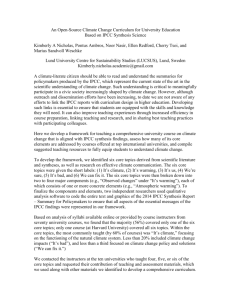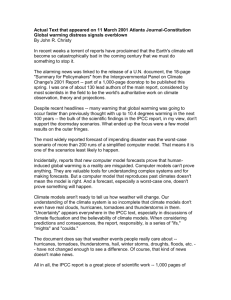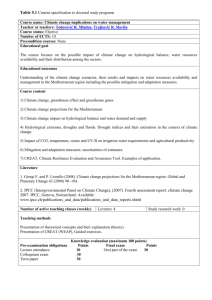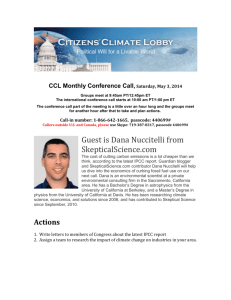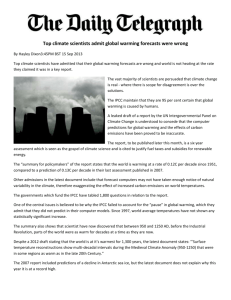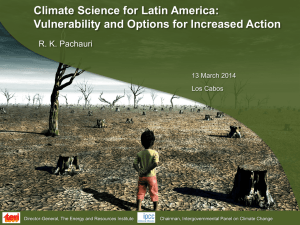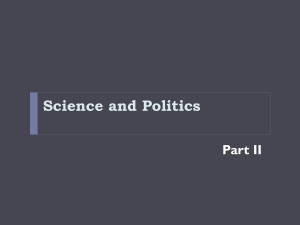Topic 1
advertisement
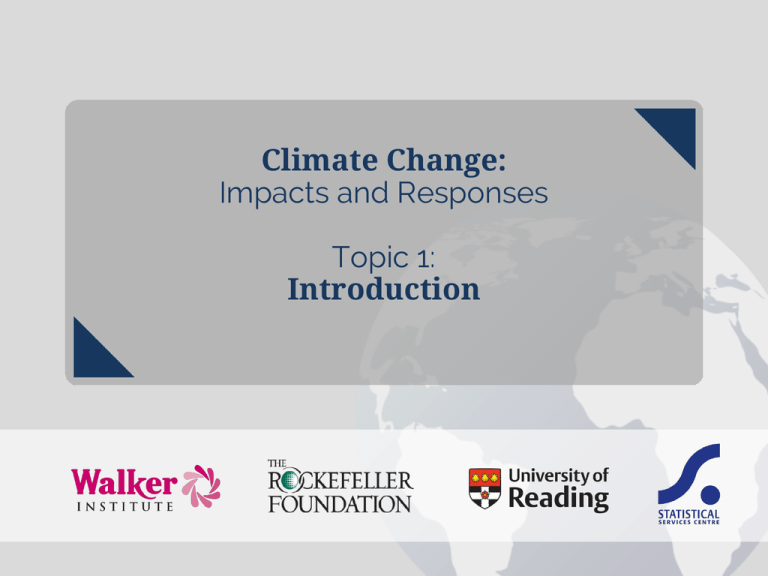
Climate Change: Impacts and Responses Topic 1: Introduction Topic outline 1. About the course 2. Climate change basics 3. The IPCC 4. Drivers of global change Image: UN Photo, Mark Garten Learning outcomes for this topic Understand the contents of the course and what you will gain by studying it Describe the basic facts about climate change and why it is a challenge Learn about the structure and operations of the Intergovernmental Panel on Climate Change (IPCC) Be familiar with a range of human drivers of global change Section 1: About the course About the course The purpose of the course Course learning outcomes The syllabus References for key readings Course purpose Introduce the topics of climate variability and climate change Deliver understanding about how earth’s climate system works, and natural and human-induced drivers of the climate system Explore the impacts of climate change on human and natural environments Analyse impacts and evaluate climate change adaptation and mitigation options Learn about the policies, regulatory mechanisms and international climate agreements associated with climate change Course learning outcomes Explain how the climate system works and the physical basis of climate change Describe how human activities are influencing greenhouse gas emissions Investigate projections about possible future climate change on Earth Assess the impacts of climate variability and climate change on agriculture and food systems, water, health, ecosystems, industry, settlement and society Identify and evaluate responses to climate change under mitigation and adaptation Evaluate global climate change policy and its implementation options for mitigation and adaptation. The syllabus Topics: 1. Introduction 2. The Earth’s climate system 3. Climate change in the distant past 4. Climate change in the recent past 5. Projections of future climate 6. Impacts of climate change 7. Climate change adaptation 8. Climate change mitigation 9. Climate change policy and regulation Key readings Textbooks Pittock A.B. (2009) Climate Change: the science, impacts and solutions. Earthscan. Henderson-Sellers, A. & K. McGuffie (2012). The future of the world’s climate. Elsevier IPCC Reports IPCC Fourth Assessment Report: Climate Change 2007 (AR4) available at www.ipcc.ch IPCC Fifth Assessment Report: Climate Change 2014 (AR5) available at www.ipcc.ch Other relevant IPCC reports available at www.ipcc.ch Course Journals Some of the key journals for scientific papers on climate change are: Journal of Geophysical Research Nature Climate Change Climatic Change Global Environmental Change Climate Dynamics International Journal of Climatology Section 2: Climate change basics Outline: Climate change basics Isn’t the climate naturally changeable? Hasn’t Earth’s climate changed in the past? How do we know humans are responsible for current changes? Why should we worry about climate change? What can we do about climate change? Isn’t the climate always changing? Image:UN Photo/Logan Abassi Climate and weather are not the same! Climate is the average state of the weather measured over a period of thirty years or more. “Climate change” refers to a shift in the state of the climate over at least several decades. Climate variability is a natural feature of earth’s climate system, but human influences on the climate can contribute to greater levels of variability than we would otherwise expect to see. Hasn’t Earth’s climate changed in the past? Image: IPCC WGI, AR5 2013, FigSPM-01 How do we know humans are responsible? IPCC 2007 AR4 WG1 Why should we worry about current climate change? Image: UN Photo, Logan Abassi Major negative impacts associated with even small temperature increases Climate change will bring temperature increases, sea level rise, erratic weather and increased extreme events, all with far-reaching implications for ecosystems, human livelihoods and national economies Unfair global distribution of negative impacts Limited adaptive capacity of vulnerable populations in many areas What can we do about it? Mitigation – e.g. change reliance on energy sources from fossil fuels to renewables like solar power Image: UN Photo, Pasquale Gorriz Adaptation – e.g. diversify farming systems to include more drought tolerant crops like millet and cassava Image: UN Photo, Gonzaelz Farran Image: UN photo, Paolo Filgueiras Global policy – financing, coordinating and regulating the global climate change response Section 3: The IPCC Outline: The IPCC The Intergovernmental Panel on Climate Change The structure of the IPCC IPCC materials and recent reports The Intergovernmental Panel on Climate Change (IPCC) Established in 1988 by the United Nations Environment Programme and the World Meteorological Organization The IPCC is a scientific body. It reviews and assesses the most recent scientific, technical and socio-economic information produced worldwide relevant to the understanding of climate change. Does not conduct scientific research or monitor climate data Aims to provide the world with a clear scientific view on the current state of knowledge on climate change and its potential environmental and socio-economic impacts “Policy-relevant and yet policy-neutral, never policy-prescriptive” Structure of the IPCC www.ipcc.ch IPCC materials Assessment Reports Special Reports Methodology Reports www.ipcc.ch Section 4: Global change Outline: Global change What is global change? What drives global change? Natural drivers of global change Human drivers of global change What is global change? Planetary scale change affecting systems on Earth, such as the climate system, ecosystems or socialecological systems. Image: NASA Earth Observatory Natural drivers of global change Plate tectonics, earthquakes, volcanoes Solar variation and Milankovitch cycles Meteorite impacts Image: NASA Image: NASA Image: NASA Human drivers of global change Population growth Economic development Image: UN Photo, A. Duclos Image: UN Photo, Rick Bajornas Human needs – drivers of change Image: UN photo, Guthrie UN Photo/Eskinder Debebe UN Photo/Kibae Park Image: UN Photo, Evan Schneider UN Photo/John Isaac Image: UN photo, Ky Chung UN Photo/John Isaac End of Topic 1: Introduction Next Topic: The Earth’s Climate System Image: UN Photo, Mark Garten
